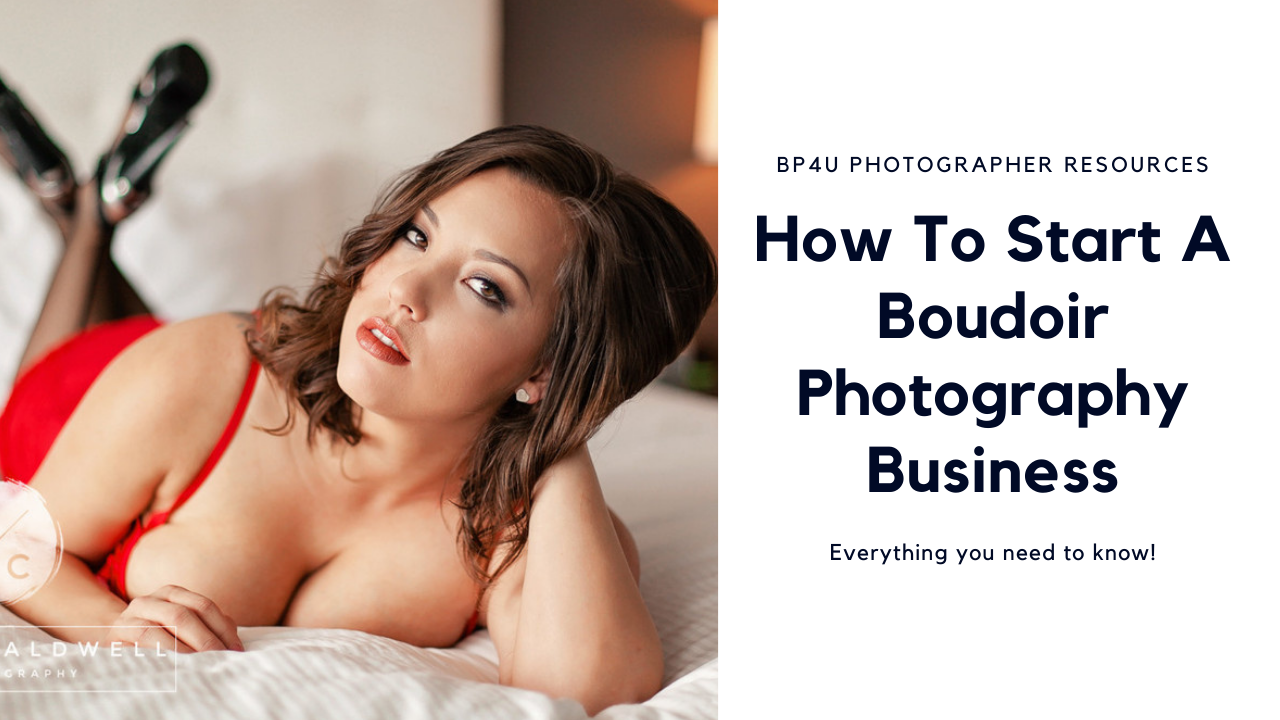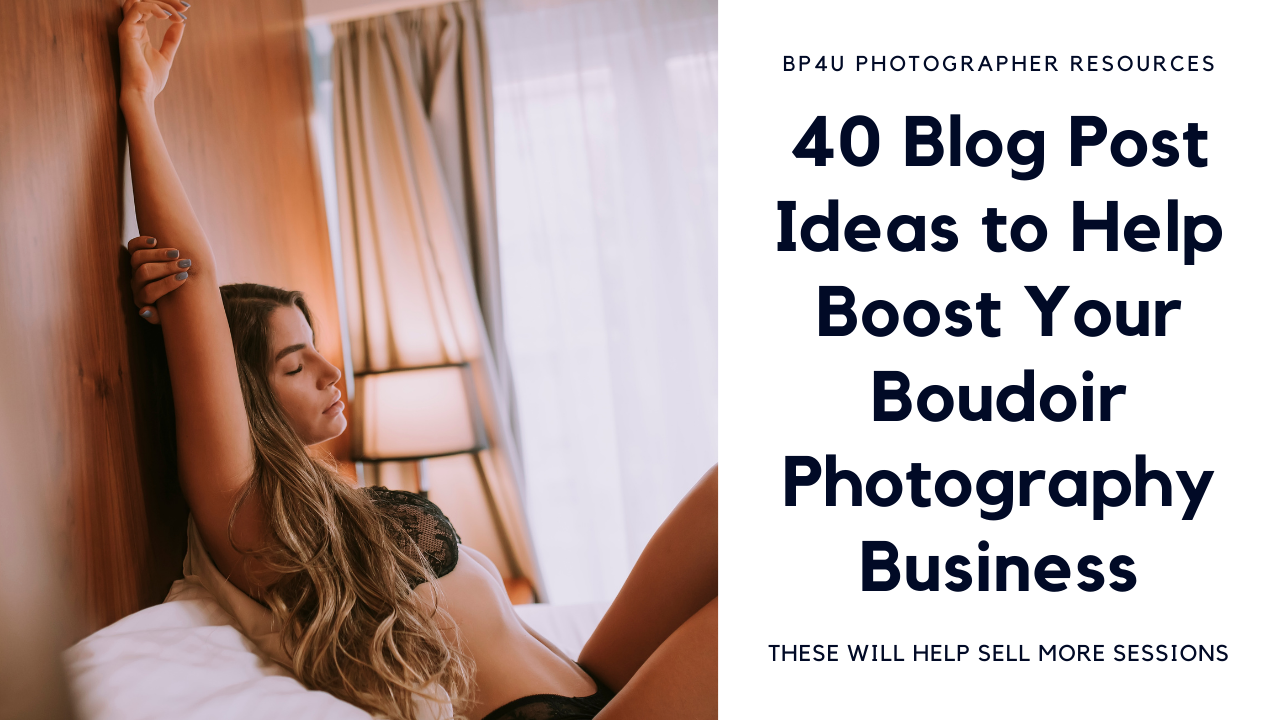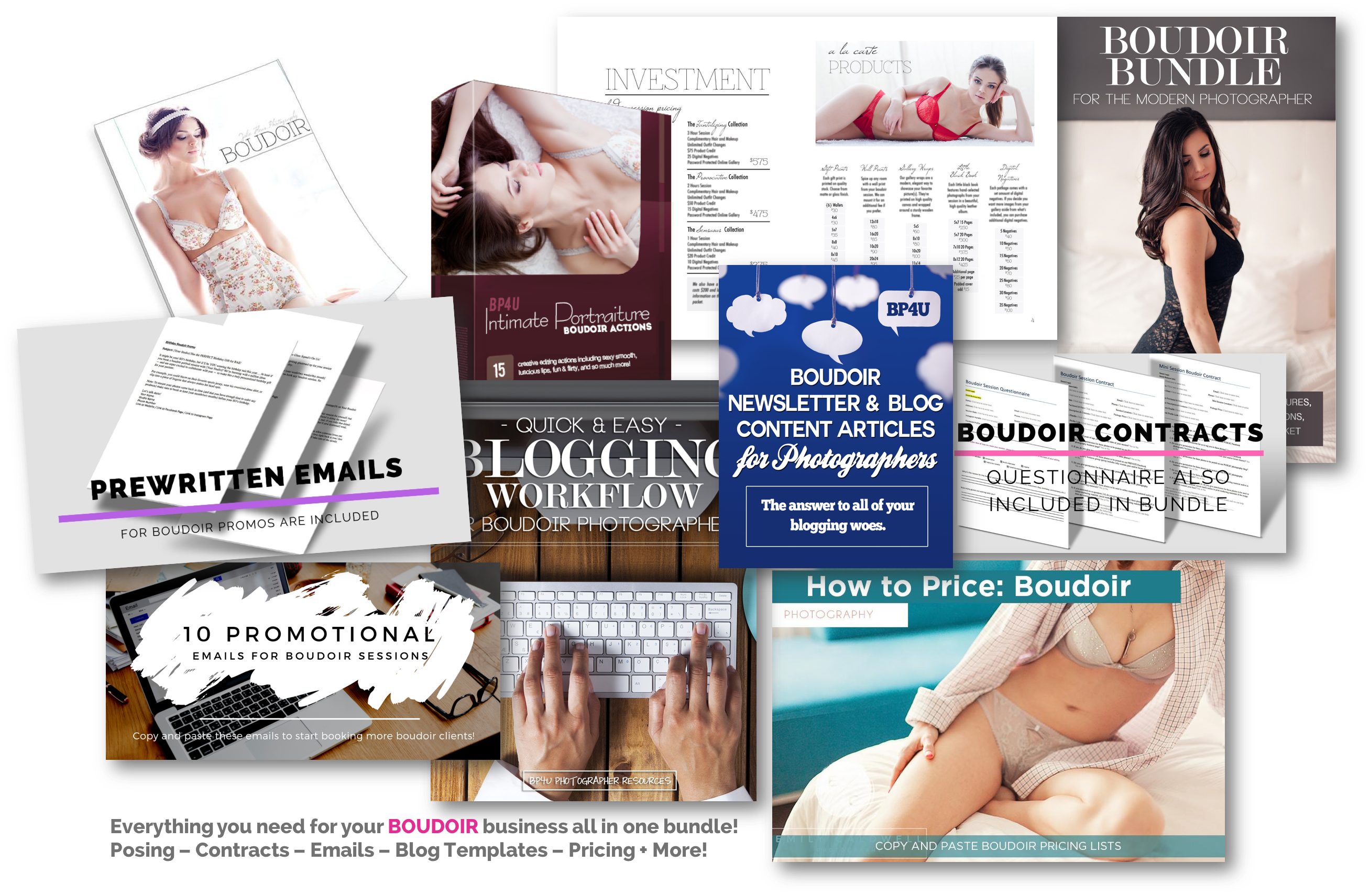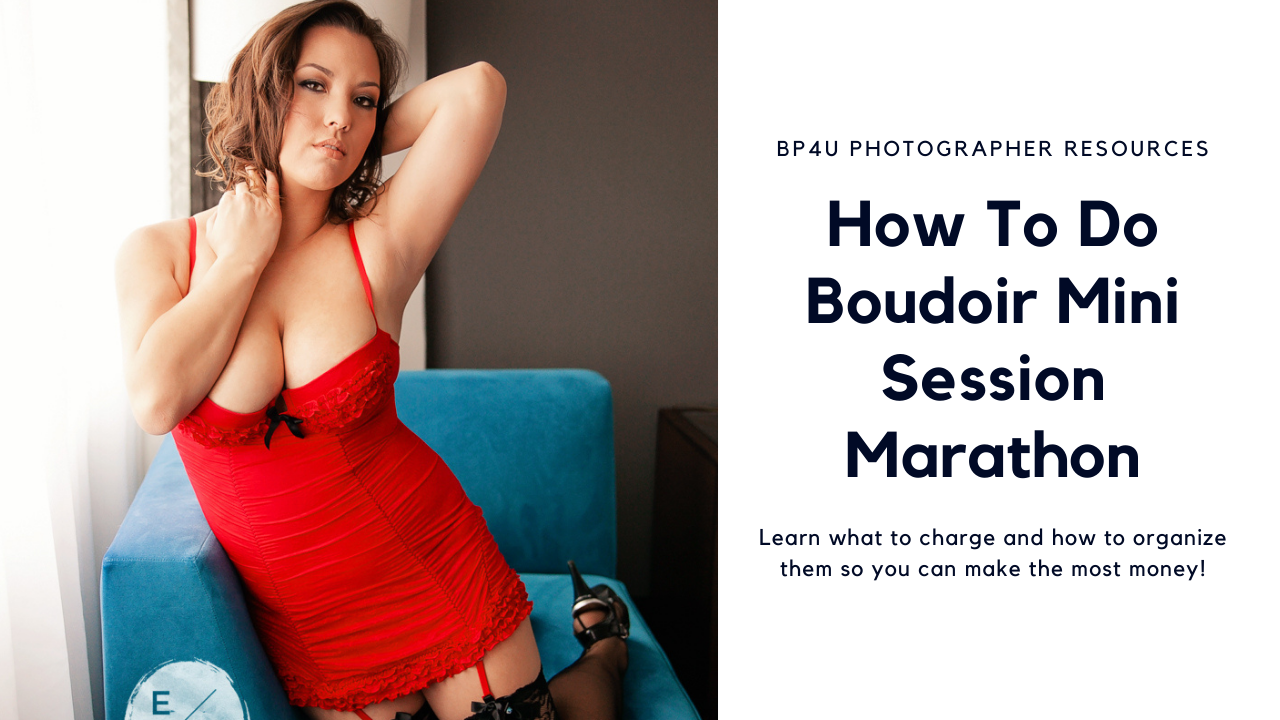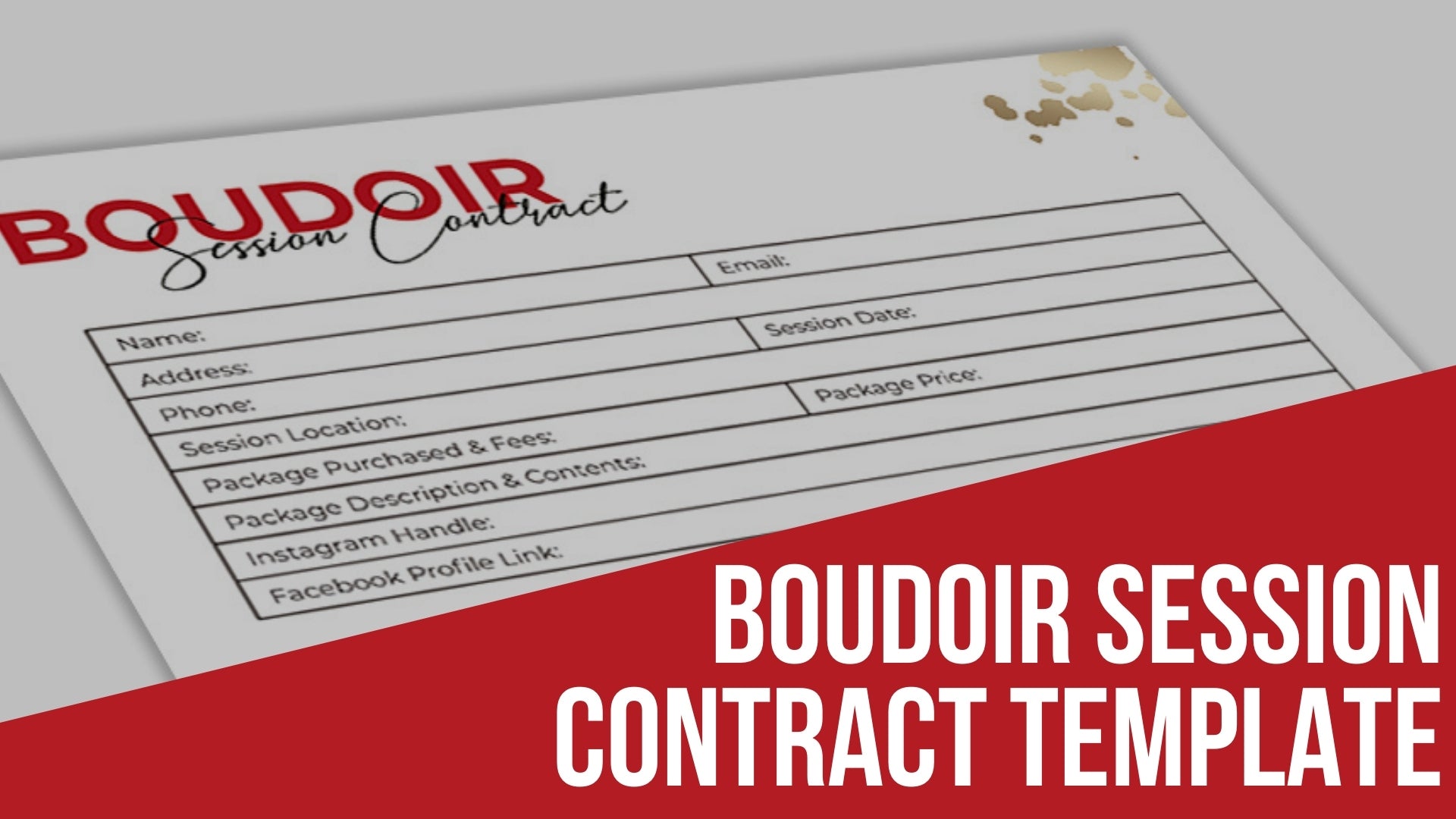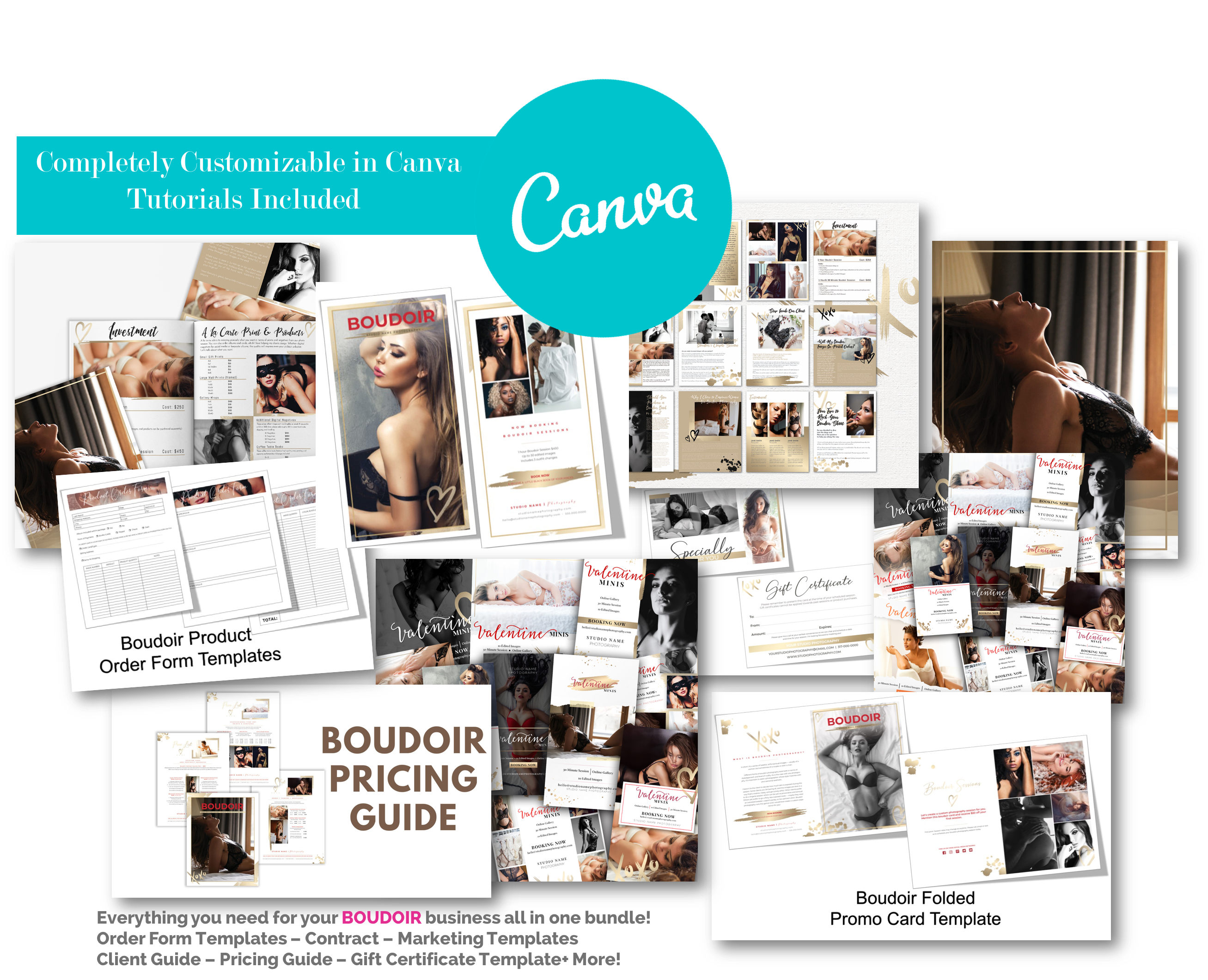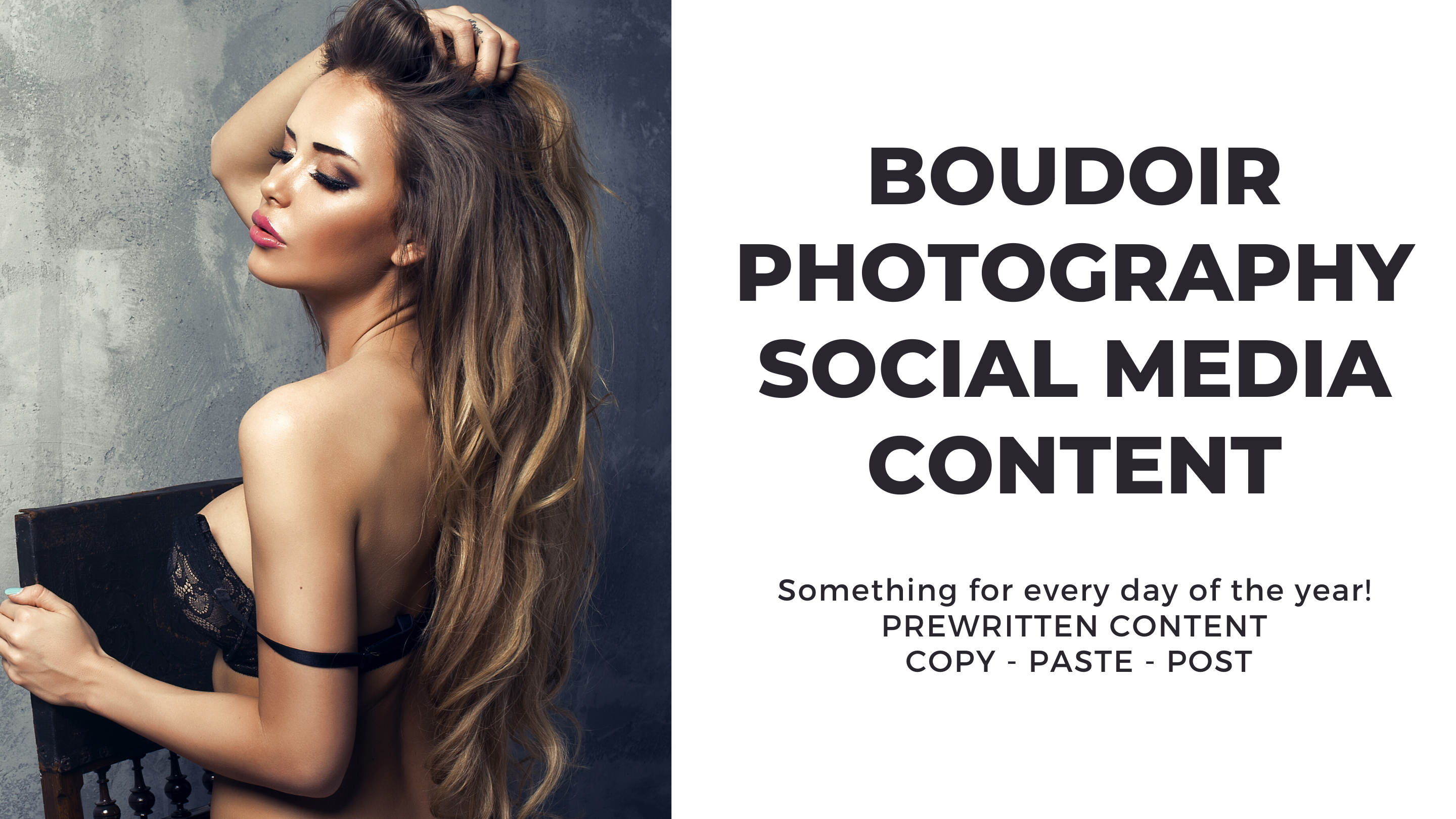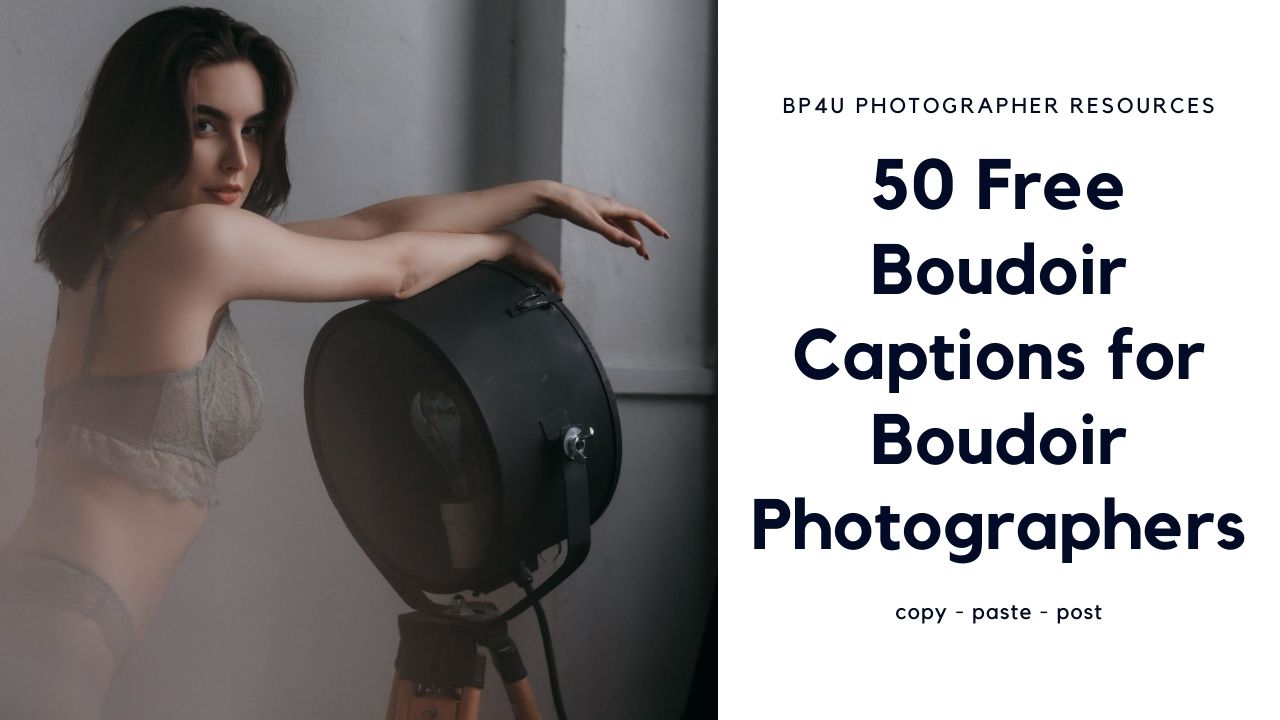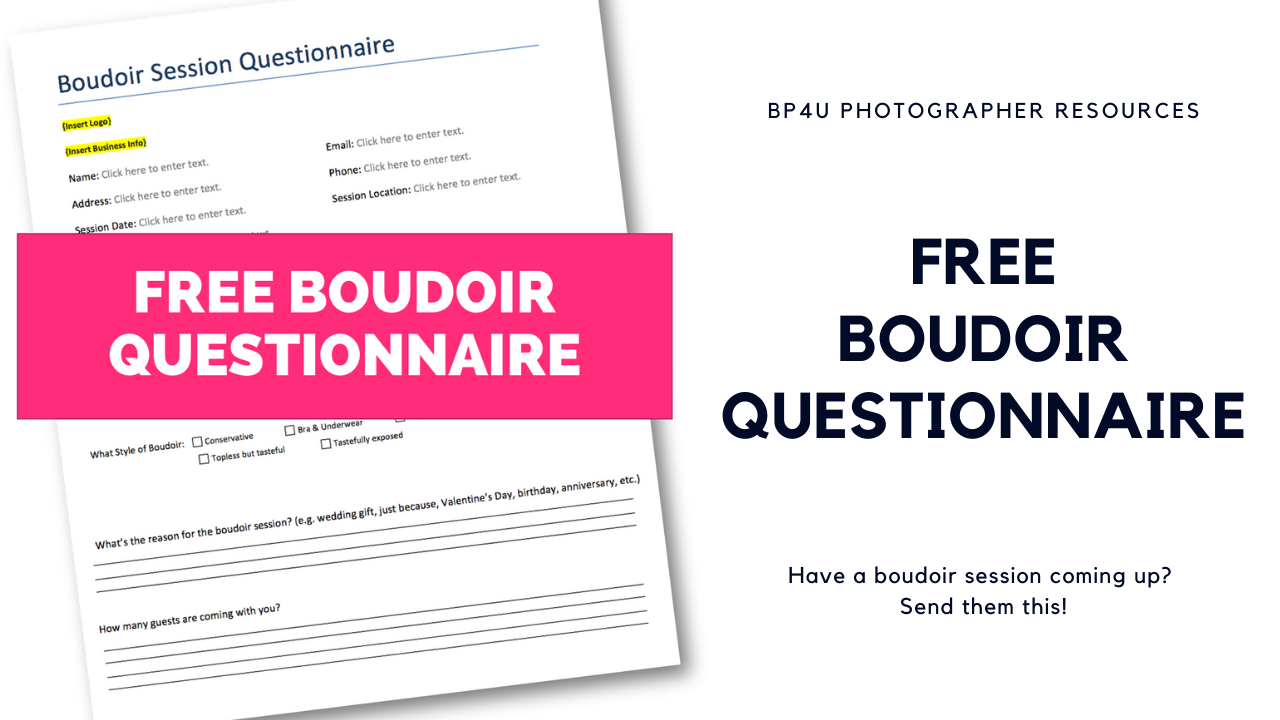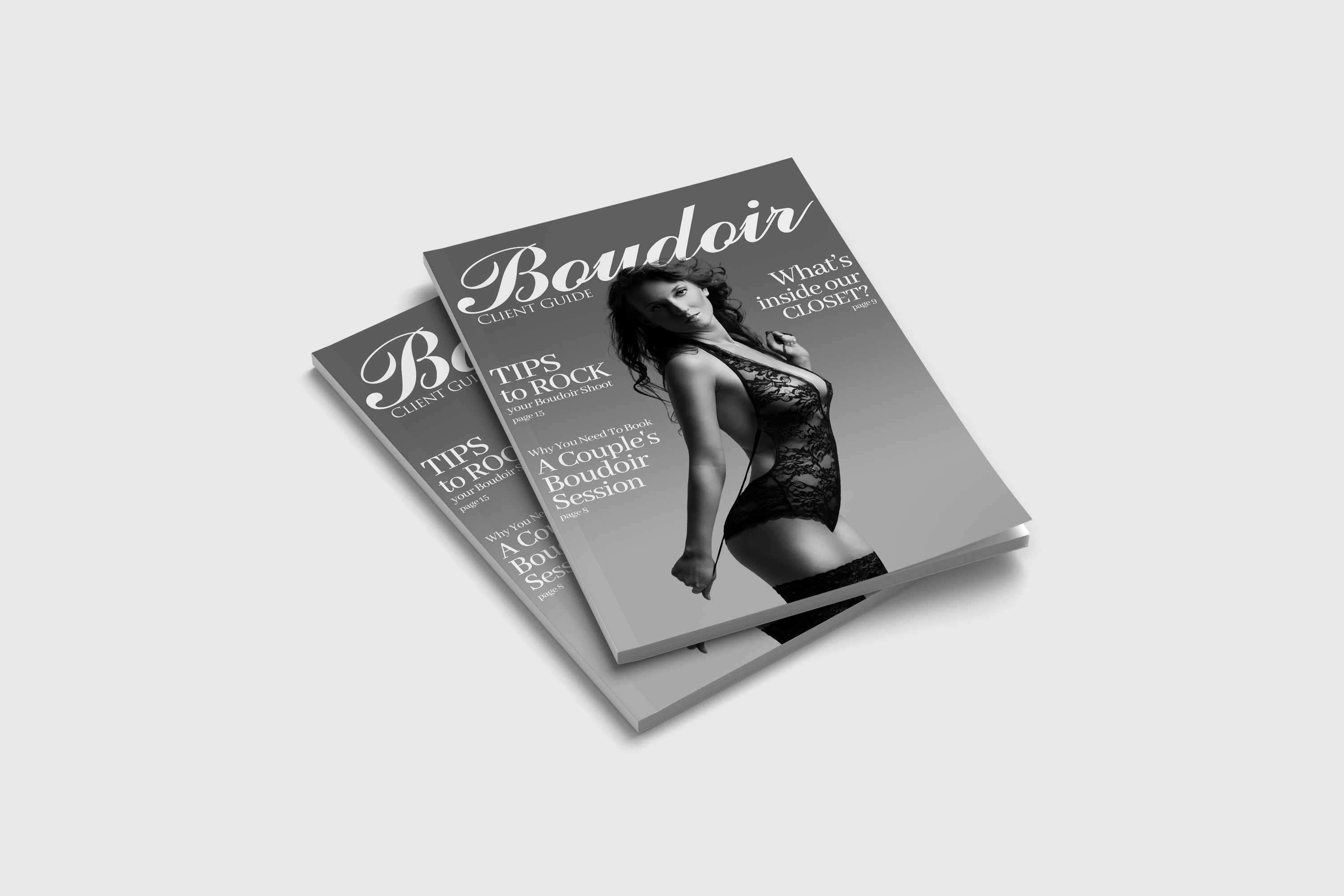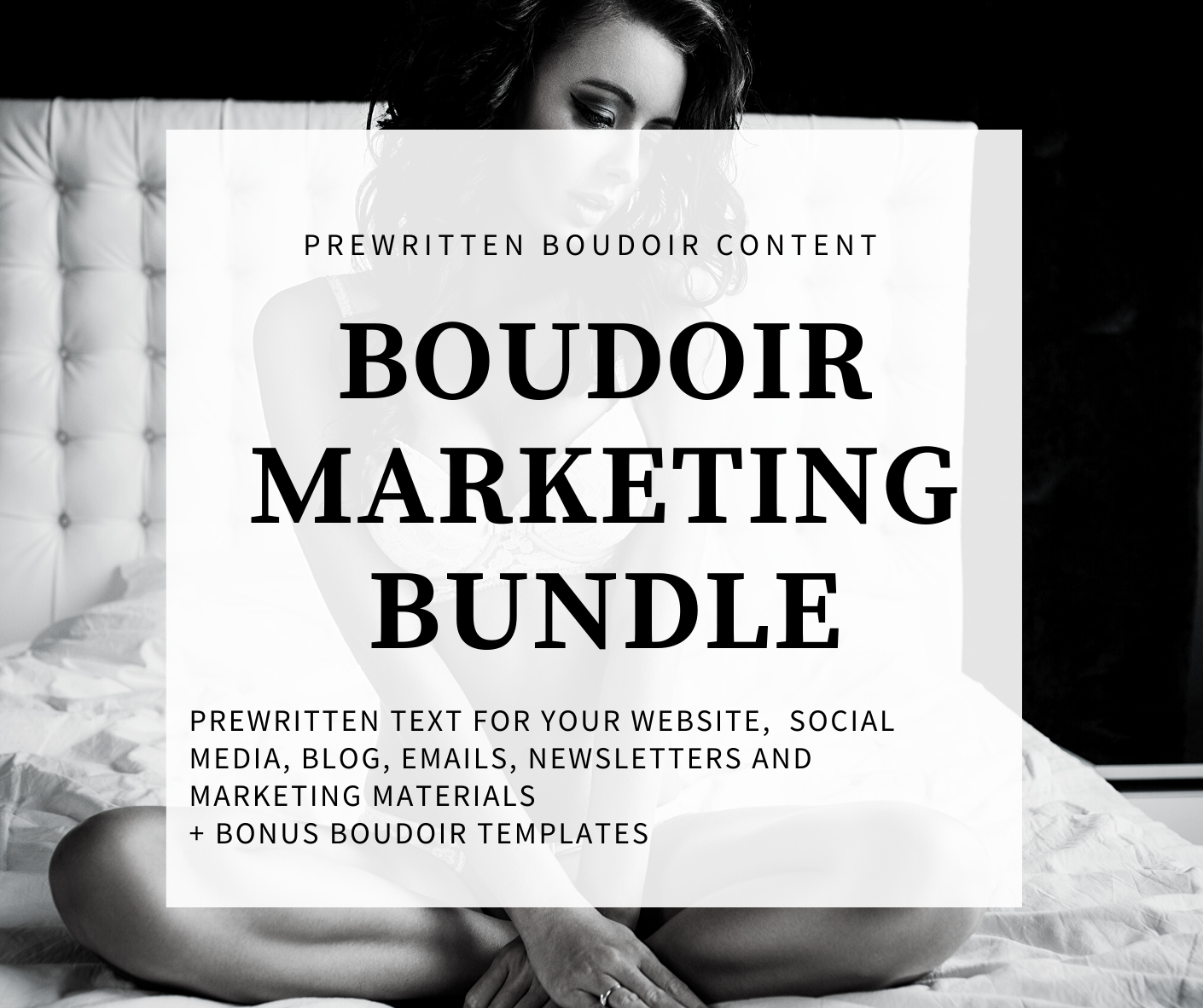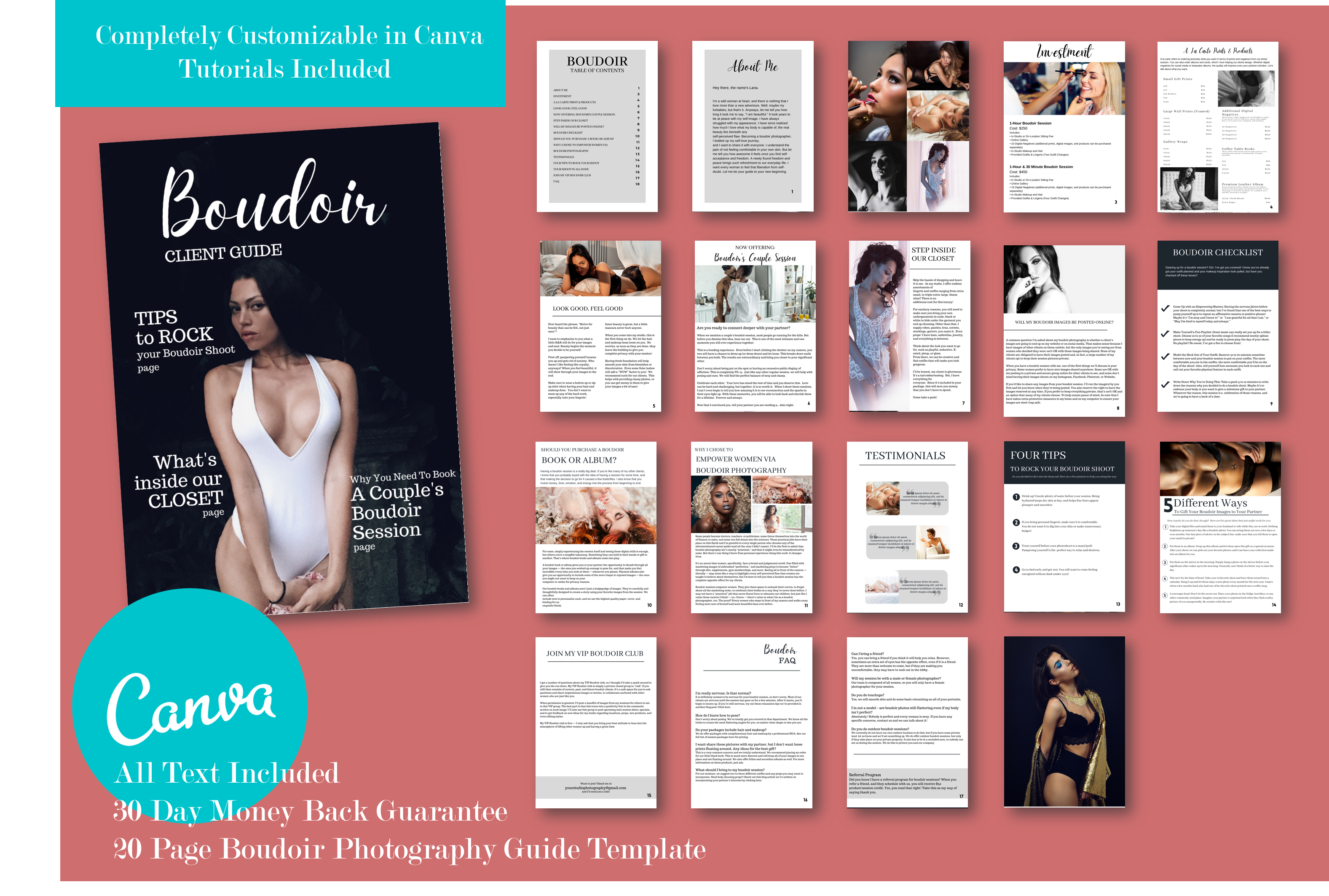Are you wondering how to start a boudoir photography business? Boudoir photography has taken off and it’s making a lot of photographers a lot of money! This blog post is packed full of information on how to get started in boudoir photography. Are you wanting to see our boudoir posing tips? Check out our boudoir posing guide.
I am so excited to be sharing with you an excerpt from our guide: Boudoir Posing For The Modern Photographer. This boudoir posing guide goes over all the poses you could need for your boudoir session plus boudoir posing cards!
All of this information and beautiful images are provided by Emily Caldwell Photography.
How To Get Started In Boudoir Photography

To get my first clients, I hosted a boudoir marathon for a killer deal (basically, enough to cover my costs and make a teeny tiny profit) and marketed the hell out of it on Facebook and to previous clients.
Luckily, I had a few boudoir-esque shots in my portfolio to use for my marketing materials; otherwise, I probably would have asked a friend to be my guinea pig. All it took was those few decent shots and good timing (it was right before Valentine’s Day!) and it took off. My marathon sold out in two weeks!
Most of my advertising took place on Facebook (both paid ads and local groups) or via e-mail marketing (MailChimp) to previous clients and those who had signed up for my newsletter.
How To Find Boudoir Clients

I would say that the vast majority of my new clients are word-of-mouth referrals from previous clients. All of my clients have loved their experience and enjoy bragging to their friends about how amazing it was and how much they love the end product.
I also gain some clients from advertisements. I occasionally do paid ads on Facebook, but only when I’m running a special or doing a marathon. I also have partnered with other local businesses (for me, they have always been other work-at-home moms who don’t have much of a marketing budget), and I will give out samples of their product or business cards in my goodie bags in exchange for them handing out my business cards, displaying my work, or telling their clients about me.
These are usually moms who sell products as well as local hair stylists. but I am always careful to make sure that whatever they’re selling is something that my target client would be interested in.
When you’re starting your boudoir photography business try partnering up with lingerie stores, salons and spas, maybe even a local chocolatier! Get creative with it. Just ask yourself, “Would my target client shop here? Would my target client be excited about getting some free swag from this store?”
Referrals are absolutely the best form of marketing for boudoir, because boudoir is really all about trust. There can be fifteen great boudoir photographers in the area, but if you have two friends and a hairdresser who just love one of them, that’s who you’re going to book with!

I sometimes send out e-mail campaigns and am quick to respond to any, “I might be interested but I’m not sure” comments. Many of my clients for my first marathon were previous clients who I had a good rapport with.
I do have a referral program ($25 print/product credit per booked and completed session), but my clients usually spread the word without using it!
Do not forget to blog all your boudoir sessions. You can also feature local businesses that your target client would be interested in hearing about. Need some boudoir blog inspiration? Check out our 40 Blog Post Ideas to Help Boost Your Boudoir Photography Business.
How To Sell Boudoir Photos During The Holidays
I love taking advantage of busy holiday seasons to get the word out and remind clients of who I am and what I do.
There’s a way to connect every holiday to your business, and any opportunity you get to remind people that you exist, you’re doing business, you’re making art, and you’re awesome at it…do it.
Holidays are just that when it comes to marketing—opportunities! Fourth of July? “Show off what a firecracker you are!” Christmas? “Let your significant other unwrap something sexy this year!” Valentine’s Day…too easy.
What To Look For In A Boudoir Model Call
I have done one model call with an application process. I chose the model who I felt was the best fit, mostly by personality. When I’m looking for models, I’m looking for someone who is comfortable in front of the camera, not necessarily someone who fits a certain look—it’s amazing what hair and makeup can do!
How Much Should You Charge For A Boudoir Shoot
My prices are based completely on my hourly rate (calculated by the following formula: Yearly Salary / (Weeks Per Year x Hours Per Week) multiplied by the number of hours that I put into each shoot (including meeting/communicating with clients, travel, shooting, editing, sales, etc.)
My products are also calculated by a formula, typical of small businesses—I like to keep my COGS (cost of goods sold) around 25 to 30%, so my markup is 400%, which allows for small discounts without impacting my business financial model.
I only change my prices when I either switch to a more/less expensive supplier for a product, or if I change my target salary.
How To Price Boudoir Mini Sessions
My first boudoir mini session marathon was $199/client with hair and makeup and three high resolution digital images included in the package.
Today, my marathons range in price depending on location, market (I shoot in two different states), and what’s included in the package. My last marathon was $389/client with hair and makeup, five digital images, and an accordion mini.
For mini sessions, the session must be paid in full to book. If it’s a marathon with a higher price point, I require half up front and the second half two weeks before the marathon.
Wanting to learn more information about boudoir mini sessions? This blog post about How To Do Boudoir Mini Sessions will help answer all your questions about boudoir mini session marathons.
How To Price Boudoir Sessions (Private Sessions)
Private sessions start at $290, but do not include any digital files, prints, products or location fees. (I either shoot out of my client’s home, rented studio space or a hotel so if they choose a studio or hotel, they are responsible for the fees). I always require a retainer to hold the date.
I typically do portrait reveal sessions for boudoir marathons, but as my marathons grow more popular, I’ve considered doing online galleries instead. The reveal sessions can be so time consuming!
Another note on my pricing: I don’t put my full boudoir photography pricing on my website. Instead, I put my base session pricing online, as well as a “typical investment” amount (e.g., “My clients typically invest a total of $800 to 1200”). I do not put my product pricing online, but happily provide it to serious inquiries.
I offer a full line of luxury products. You can see the breakdown of pricing for my sessions and products below.
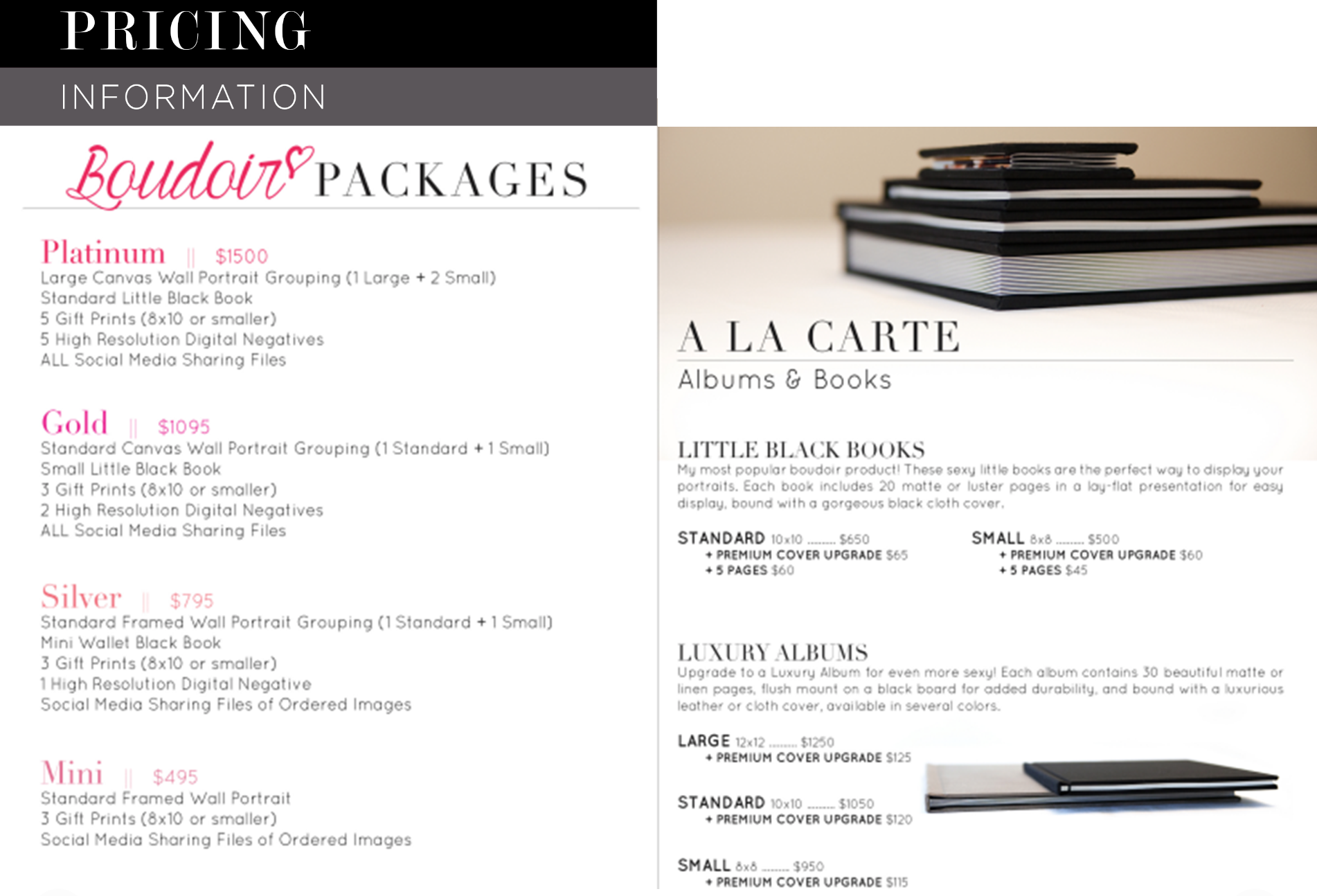
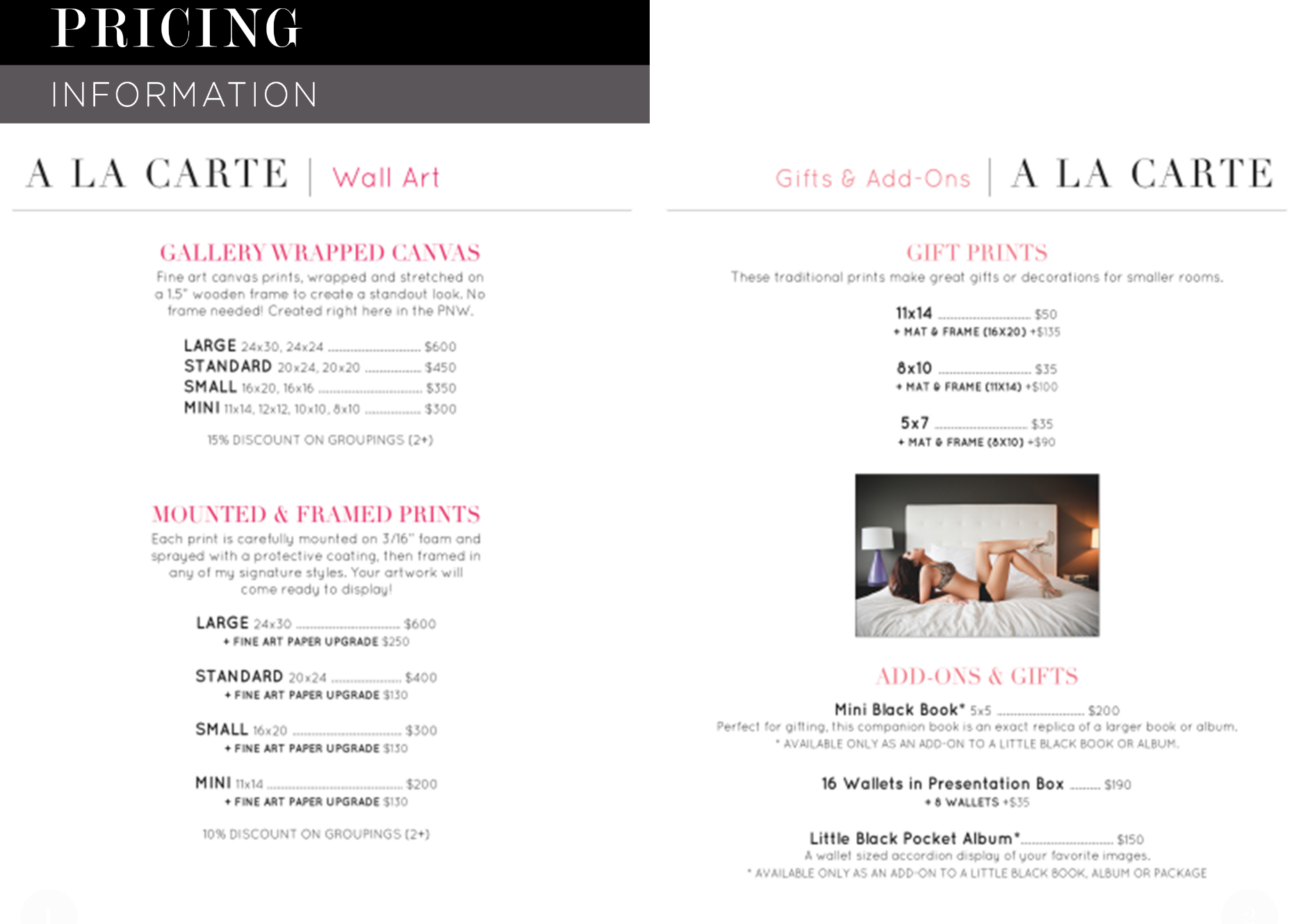
The Importance Of Boudoir Photography Contracts
Contracts are absolutely essential to boudoir business. You must have a contract with any portrait client, but especially boudoir! Your contracts should also be looked over by an attorney in your state to ensure that they actually protect you instead of just giving you a false sense of security.
When writing your contracts, think about as many possible situations as you can and be very clear about your policy.
Make sure that your contract is readable, but also that it touches on everything important to your business. I highly recommend reading over the contract in detail with your clients and answering any questions they have before they sign it, or at the very least, before the session.
Just because someone reads a contract does not mean they read and understand it, and while your contract may cover you should a problem come up, that doesn’t mean your client won’t complain to anyone who will listen if they feel you didn’t explain things well!
What Should Boudoir Photography Contract Cover?
My contract covers all the following:
- Terms of reservation (session must be paid and contract must be signed for the session to happen)
- Copyrights and exhibition (including terms for using or displaying the images for profit)
- Model release
- Limit of liability (including both injury and loss of images)
- Weather policy (this is important even if you shoot indoors only—what happens if there is a tornado or flood?)
- Props
- Appearance (if you use a hair and makeup artist, be sure to let your client know that they are responsible for communicating with the HMUA and that you are not liable/will not do a reshoot for dissatisfaction with the client’s appearance)
- Locations (including access and fees)
- Outfits
- Tardiness
- Cancellations
- Completion schedule
- Product ordering (my contract includes that there is an additional charge for additional ordering appointments)
- Archiving (how long you keep the images)
- Privacy Clause (where the images can be used online)
I’ve had clients with totally outlandish requests for re-edits, new copies of their images over a year later, RAW images, etc. In these cases, it’s so nice to have a contract instead of having to explain to a client why I don’t freely give certain services or files, etc.
Of course, I don’t want to have to explain to a client that I basically don’t trust anyone with my RAW images and that they probably don’t even want to see their RAW images, so it’s nice to just be able to say, “I’m sorry, but as per our contract agreement, I cannot give RAW files.”
I’ve definitely had situations where clients’ expectations weren’t set properly and so I needed to re-word or add to my contract, but I’ve never had to write a new clause for something a specific client did.
Contracts definitely include a little trial and error, but it’s important to cover as much ground as you possibly can and make sure your client reads the contract and understands it in full. I now go through every single section of my contract with my client at the session planning meeting, even if they have already signed the contract.
This saves me from questions like, “Can’t I cancel my session and get a full refund?” or, “I thought I was getting all of the digital images!”
The Importance of Privacy In Boudoir Photography
Privacy and boudoir go hand in hand. Your client will not feel comfortable if they don’t feel like their privacy is protected, so it’s very important that you touch on privacy not only in your contract, but in pre-session conversation with your client.
You should never post a photo anywhere on the internet with your client’s full name. I never use more than a first name and last initial, but even the last initial is used very sparingly. Be sure you have written permission from your client (model release!) before posting any image of them or any information about them.
Be as up front and straightforward as you possibly can about privacy. Any time you’re considering posting an image of a client, ask yourself how you would feel if the same image of you was used in the same manner. If the idea makes you uncomfortable at all, clear it with your client or don’t post it!
What Boudoir Photography Should I Post on Social Media

I have both a private Facebook group and a fan page. The fan page covers my entire photography business, whereas the private group is exclusively for boudoir. I started the group to give potential clients a safe and comfortable space to look at my work, talk with me, and also see my interactions with other boudoir clients.
It’s sort of an opportunity for them to stalk not just my work, but also me and how I communicate with my clients. I think it’s so important for potential clients to see how comfortable my previous clients are with me, and they also get the opportunity to chat with other clients and ask them about their sessions.
I also like that I can screen who sees the group. No men and nobody under the age of 18 are allowed into the group, which gives my clients a little added privacy when I’m sharing their images.
I don’t show images with too much of a sexy factor on my public Facebook page; super sexy images are shown exclusively in the group. I don’t want my clients to have to worry about their dads, male coworkers, etc. stumbling across their boudoir photos on Facebook!
I want to reiterate that I am very careful about who I allow to join the group. I check out the pages of everyone who requests to join. Facebook tells me how long they have had an account, and if it’s less than a few months, I automatically deny them. (YES, I’ve actually had a few people create Facebook accounts just to get into the boudoir group!)
If their profile isn’t public enough for me to tell if they are human or not and we don’t have any mutual friends, I send them a friend request and then remove them from my friends list after I’ve viewed their profile. I only approve people whose profiles show that they are genuine, real women.
I don’t post everyone’s session photos in the group. I give my clients the option to choose from Facebook, blog, and printed marketing materials when signing the model release. If they do not choose Facebook, I don’t share their images in my group.
Check out our Boudoir Captions For Boudoir Photographers if you’re needing Instagram caption or Facebook post ideas for your boudoir photography.
Where To Start A Photography Business

Are you worried about where to start a photography business? You don’t have to have a studio to start a boudoir photography business.
Time and creativity are key to choosing a location! There are tons of ways to find a studio rental. I’m in local photographer groups on Facebook, and many photographers rent out studio space (often with equipment included!) when they aren’t using it. I’ve also found small businesses who rent out very useable space on their off days.
But you can shoot boudoir anywhere! Depending on your client’s comfort level, shooting in an open field or forest might be a perfect match. Hotel rooms are great, too, and often the price is comparable to renting studio space. (Bonus—mini hotel vacation for you or your client after the shoot!)
The most important thing to look for in a boudoir location, obviously, is privacy. Always be respectful of your client’s comfort level and don’t try to push them into a location they aren’t comfortable with.
What Kind Of Lighting Do I Need For Boudoir Photography
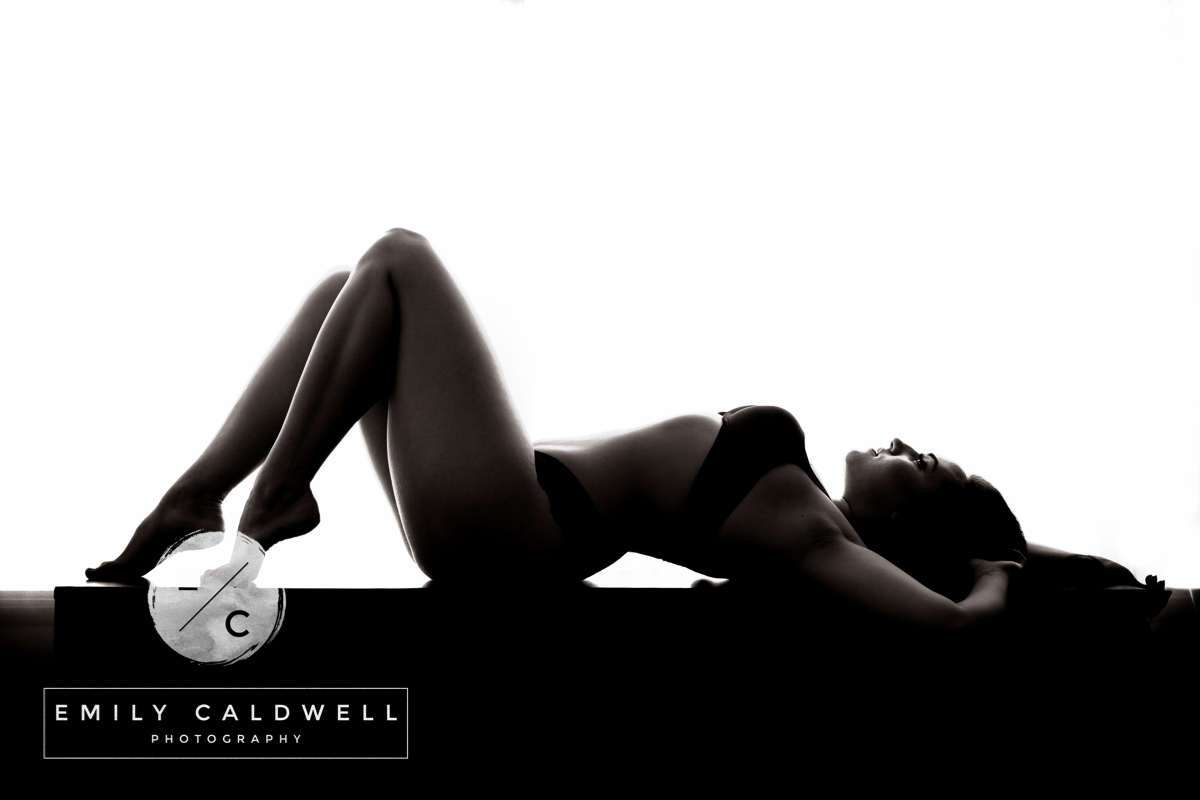
Lighting is the second most important thing when you’re figuring out how to get started in boudoir photography.
I always look for good window lighting. I like a clean, airy look in my portraits, and this is best achieved with natural light. I do supplement natural light with small strobes sometimes, but if a location doesn’t have lots of natural light, it’s just not a good match for my style.
Some photographers are the opposite; they prefer working solely with strobes and therefore scope out locations with little to no natural light. It’s all dependent on your preferences, but light is so important!
I almost always shoot boudoir sessions in a room that has one huge window and that gives me a lot of options – it gives me the option to do backlight or to get really good, even light on the body, or it gives me the option to light from the side and create some shadows.
Then I don’t have to mess with any artificial lighting at all. Because I’ve got everything I need. One giant window. I think that’s something I really look for in a room whenever I’m choosing where I’m going to shoot. Not just big windows, but to have them all on one wall is really helpful.

Because then I’m not trying to mess with angles and light coming from two different places. I like to have one lighting source. Unless I’m using a fill light, I rarely use it, unless I’m starting to run out of natural light.
If you rent a hotel room for a boudoir session, try to find a boutique hotel that matches your client’s style instead of getting the cheapest room you can find. While you can always bring props to spice up an area, every detail matters.
How Much Space Do I Need For My Boudoir Photography Session
You need space to shoot boudoir. You don’t want to have to shoot an entire session with a 35mm and be all up in your client’s grill. The more space, the better.
How To Shoot Boudoir Photography In A Hotel
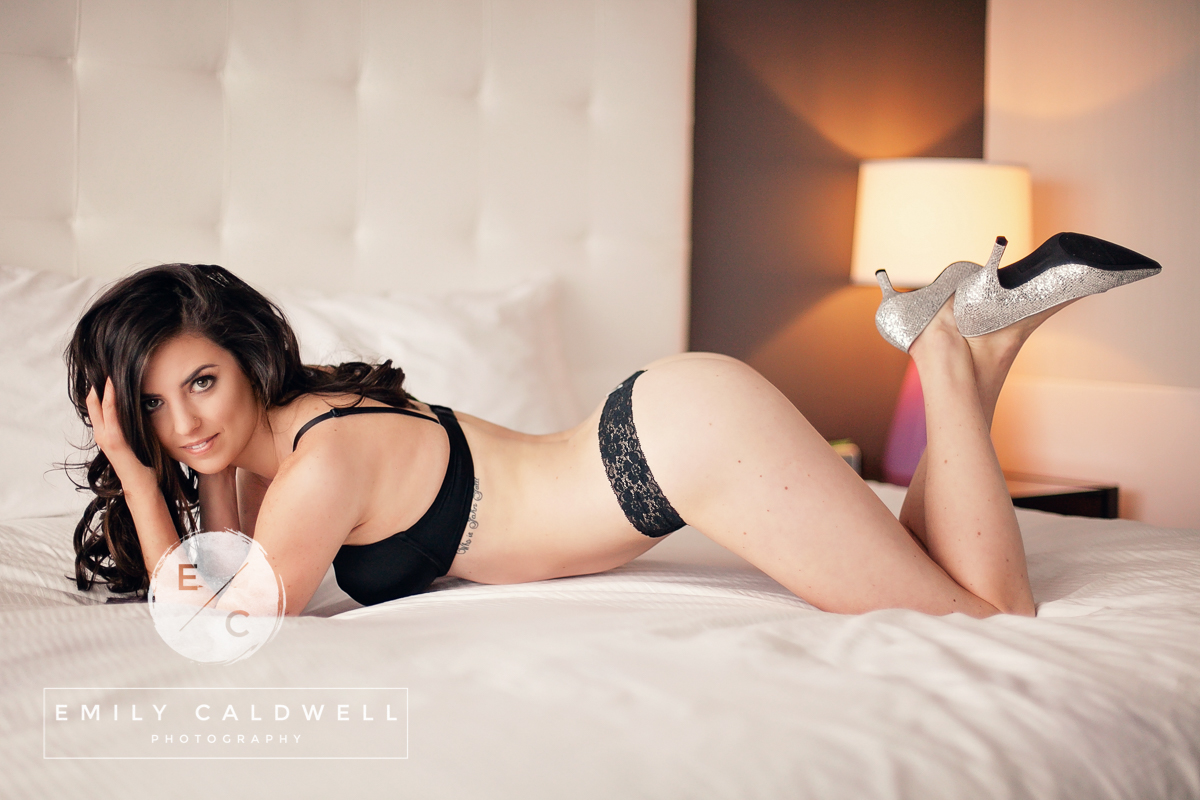
Most of my sessions are marathons and take place in hotels. If it’s a marathon, I pay for the hotel room and the split cost is included in the session fee. If it’s a private session, my client pays for any location fees.
It’s not a requirement, but I do let hotels know that I will be photographing clients in the room. Be sure to check with hotels ahead of time on security policies—one hotel I photographed at required a room key to get in the elevator, so they needed to have a list of clients before the sessions started so they could disperse elevator keys and minimize interruptions to my shoot.
I have never had a contract with the hotels. Most hotels do not care what you’re doing in the space, as long as it’s legal and you’re paying for it!
I try to keep the room at a comfortable temperature. Not too cool, since my clients typically aren’t wearing a lot of clothing. But not too warm, either. There’s nothing worse than a beautiful hair and makeup job ruined by sweat! I try to stay around 70 to 72 degrees, erring on the warmer side, and keep a fan on hand in case my client gets warm. I’m always careful to ask my client if the temperature of the room is comfortable so I can adjust as needed.
I bring my own (all white) bedding just in case the bedding provided isn’t working, but I try to work with what’s provided, especially if it’s something the client likes. I wash my bedding daily. If a client is planning to do any fully nude or between-the-sheets shots, I ask them to bring their own bedding/sheets.
Who Books The Hotel For Boudoir Photography Sessions
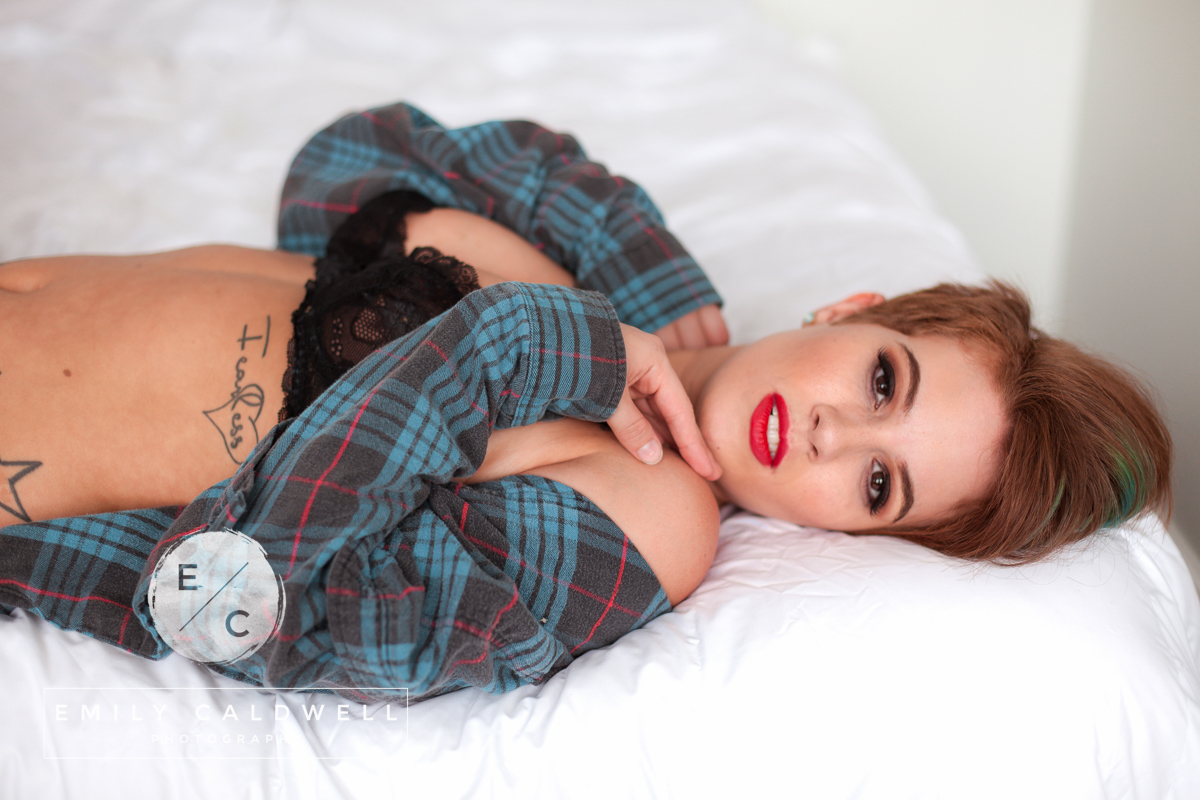
For marathons, I book under my name. For private sessions, the client is responsible for booking and paying for the room. Of course, I offer them guidance about which hotel to choose and accompany them if they want to tour a location. But, since they are paying for it, it’s in their name.
Levels Of Boudoir Nudity
In my questionnaire, it asks what level of nudity my client is comfortable with. I want to take just a moment to explain the difference between these items:
- Fully Clothed
This would be a client who either wants to wear clothing for the entire session or who is only comfortable with full coverage panties and bra on.
- Implied Partial Nudity
May take the bra off and do some panties-only shots from the side or behind. May also request some detail shots where it appears that they are partially nude, but really they are wearing full underwear (for example, a shot in just a towel)
- Implied Full Nudity
Most commonly, this is “between the sheets” shots. The clients do actually get fully nude for these shots, but the key is that I usually do not see them nude and obviously do not photograph any sensitive areas either.
- Topless
This can be panties-only shots where they are covering nipples, or it can be shots where they are just plain topless! Some clients like to show nipple, others do not.
- Partial Nudity
This is sometimes the same as topless, but can also be full back nudity to show off the booty or full frontal nudity where they have their legs crossed or something to cover lady bits. I know that this is technically full nudity, but I don’t offer the full nudity option because I want all of my clients to understand that I don’t and will not offer/ask to shoot vaginas.
I’ve shown some examples of all of these levels below.
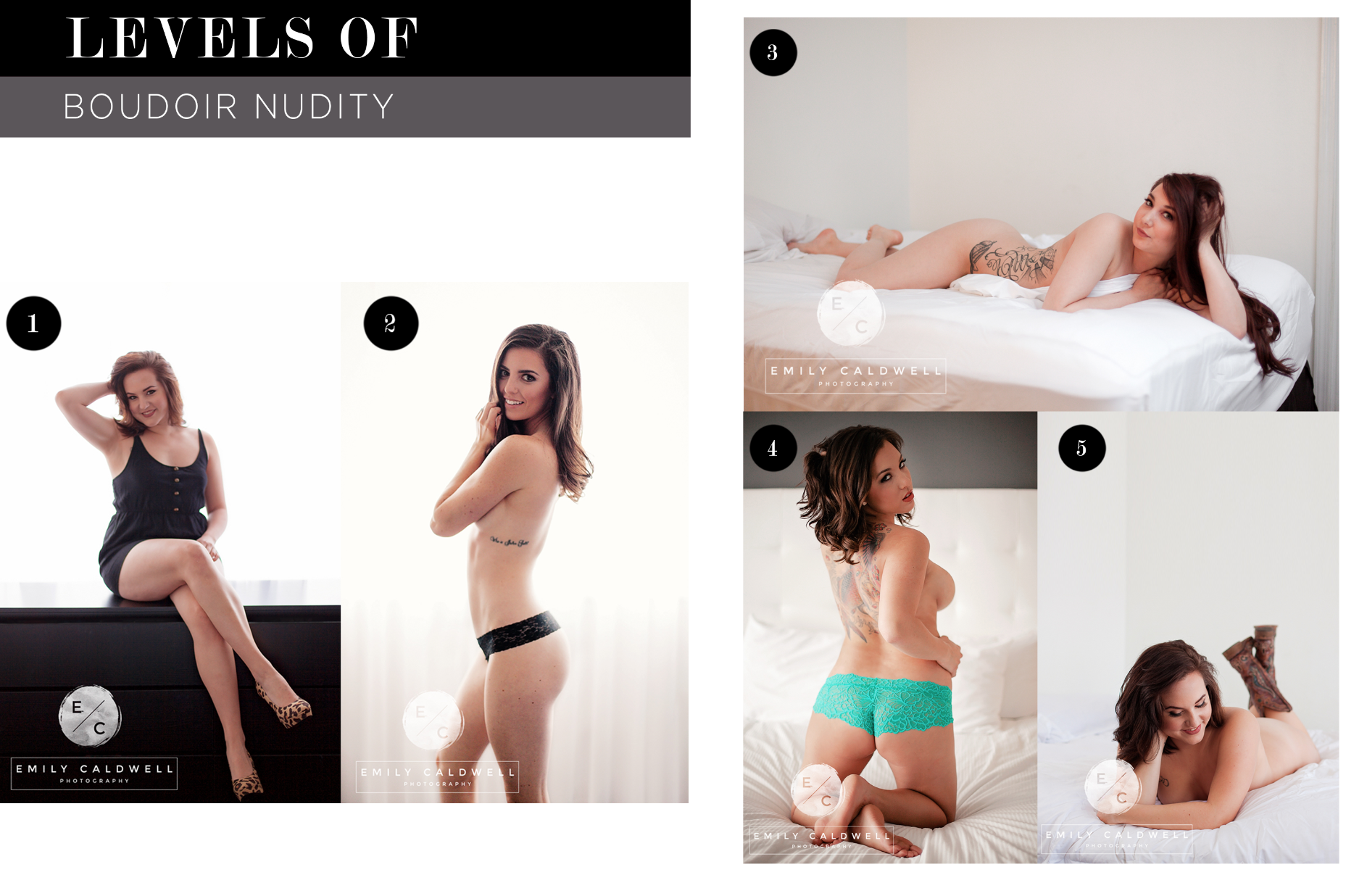
How To Work With A Hair and Makeup Artist for Boudoir Shoot
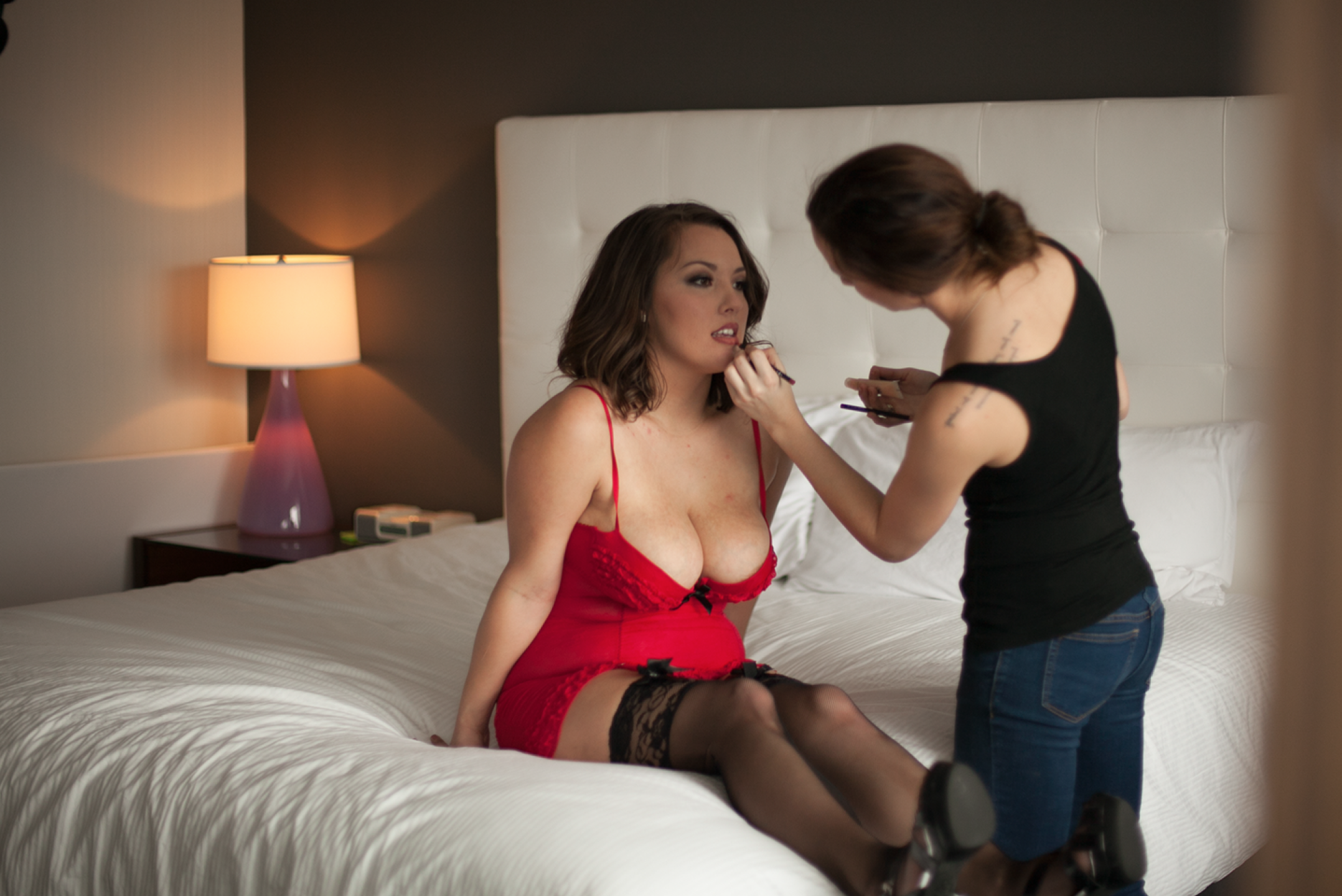
Hair and makeup is part of my full client experience and I believe that including hair and makeup is absolutely essential to a memorable boudoir photography experience. I include them in all of my packages.
I have found vendors through Thumbtack, Model Mayhem, and word of mouth referrals from other photographers. They typically give me special rates for marathons, where they are guaranteed a full day of work. I do not ask for special rates for full sessions. Typically, the special rate I’m given for a marathon is the same rate they give for a full bridal party.
They work on location, and they stay for the session in case touch ups or style changes are needed. I budget one hour for hair and makeup when it is done by the same person, and just a little more (15 to 30 minutes) if I have a separate hair stylist and makeup artist.
I love my HMUAs (hair and makeup artists) and I love to send extra business their way, as they are often so flexible for me and are such an important part of my business. I promote their business on my social media pages whenever they have worked on a session.
Boudoir Photography Mini Sessions:
Are you wondering how to start doing your boudoir minis? Can’t figure out what to charge for your boudoir mini sessions? Check out How To Do Boudoir Mini Session Marathon.
Boudoir Photoshoot: Your Questions Answered
How many boudoir sessions do you typically book in a week?
No more than two private sessions per week.
How far apart do you spread your boudoir sessions?
No more than one private session per day, unless I have two clients who are wanting to rent studio space and share the cost. Then, I will shoot them back to back.
Do you only shoot boudoir on certain days of the week?
I prefer to shoot Thursday through Saturday, but I try to be flexible with my clients’ schedules. I do not shoot or meet with clients on Sundays or Wednesdays, ever. This is family time only!
How long does a boudoir shoot normally last?
An hour and a half is usually just the right amount of time, but if we’re getting great shots and everything is moving smoothly, my clients have up to two hours of session time.
How do you deliver your boudoir photos?
Most of my clients pick up their order directly from me. We look at it together, confirm that everything looks great, and that’s that! If it’s a digital only order, I usually deliver via Dropbox.
Do you use flash or other external lighting for your boudoir sessions?
I use two wireless flashes, one in an umbrella and one in a softbox, as needed. I prefer to work more with natural light and reflectors (in a pinch, a large white board from Hobby Lobby works great!).
What tips do you give your clients prior to the session?
Most of my tips are in my boudoir client guide. In this welcome packet, I introduce myself and give them information about how everything works. I go over a timeline, what to wear, accessories and props, how to prepare for the session, frequently asked questions, and pricing packages.
This boudoir client packet is loaded with all of the important information that clients need to know. Sending this to them also helps eliminate a lot of back and forth communication, because it answers the majority of their questions right off the bat.
How do you make the client feel comfortable when so exposed during the boudoir session?
I talk pretty much the entire time I am shooting. There is very little “quiet time” during a session. I also let them talk as much as they like. I ask them questions, make jokes… I usually make a fool out of myself at least once or twice by tripping over something or making a funny face while shooting!
I have a pretty silly personality—not immature, just fun. I’m not afraid to laugh at myself and I’m always super open with my clients. Of course, it’s important to still be professional if you want your clients to trust you, but don’t be afraid to have fun.
Do you meet the boudoir client before the shoot so they can get comfortable with you?
Absolutely! If we can’t meet in person, we do a Skype meeting. This meeting is not only so we can get to know each other, but also to go over the contract (I go over it in great detail with them!), outfit selections, and possible themes or ideas for the session.
Let’s say you have a client that is insecure about her back fat. Do you not shoot that part of her body or do you edit it in post and tell the client not to worry about it?
I take very few shots of the back, but I do shoot it and tell them, “It’s such a super easy fix and I think you’ll really love how your booty looks!” I make sure they know I’m trying to accentuate something else, not the problem area, when it is exposed.
When it comes to boundaries and limits, what’s your policy?
I don’t shoot vaginas. I do implied full nudity. So I’ll shoot booty or boobs fully nude, but not vaginas. If I were commissioned for a session that had an obvious “fine art” feel to it, I would be a little more lax on that policy. However, I want to make sure my sessions have an overall classy look and feel to them, not pornographic.
Have you ever had a client ask you to do something that you’re uncomfortable with? How did you handle that situation?
I’ve had clients ask to bring their boyfriend/husband to the session, which I’m not comfortable with. I just explained to them that it makes me uncomfortable and it would probably just make them more nervous, too. When it comes down to it, honesty is the best policy, especially when it comes to comfort or safety for both your client and yourself.
What advice do you have about tanning and spray tans prior to the session?
Do not tan the week of your session! Even if you have a good base tan. The base tan will stick around if you don’t tan for a few days, and will probably look great on camera. But an accidental burn will make you uncomfortable and just be more work for both of us. Especially do not spray tan—even the best of spray tans can look orange on camera.
Do you do boudoir session sneak peeks?
I do one sneak peek in the private boudoir Facebook group. I am careful to make sure it’s not the best image from the session, though—I don’t want to give away the best image when I don’t even get to see a reaction! 🙂
Do you sell your boudoir sessions on your normal Facebook page?
Yes, but I am much more selective about what images I show publicly for marketing.
How did you name your boudoir business? Do you have a separate company name for boudoir, or is it all one company with other portraits that you shoot?
I currently shoot everything under one name, but I am toying with the idea of creating a separate boudoir company.
Do you use props for your boudoir shoots?
I rarely use props for boudoir. When I do, they are catered to the client’s style and taste. If I happen to have something on hand (previously, a bottle of Jack Daniels!) that fits really well with the theme of the session, I bring it along. But otherwise, clients are responsible for bringing their own props, though I’m happy to give suggestions and help pick them out.
How do you incorporate the partner’s hobbies/interests into the session? What if they have weird props?
I’ve worked with all kinds of weirdness! BMX gear, guns, hats, jewelry, flannel shirts, even a baseball bat. It can all be incorporated in some way. You really have to get creative here, of course! I usually try several different things with each prop and see what works best. If it’s just too weird to work, I’m honest with my client and ask if she has any other way to bring in some of her significant other’s style.
Do you give your hair and makeup artists some images from your sessions for them to use in their portfolio as well?
Only when it is worked into their contract. If I work with a HMUA who is up-and-coming and working on building a portfolio, sometimes I will contract them for smaller monetary compensation plus a certain number of images for their portfolio. However, if I am paying the full rate, images are not included in the contract.
Do you recommend that your clients get their nails done prior to the session?
Absolutely. I recommend that they do as much pre-session pampering as possible. I provide them with a checklist of things to do (if they desire) before their session.
Do you have your own boudoir studio?
I do not have a studio right now.
Do you do boudoir sessions during the day or at night?
I’ve done both, but I prefer to shoot during the day so I can have plenty of natural light.
What’s the strangest edit request you’ve had?
I really haven’t had anything too odd yet! I’ve had a few tattoo removals, but they were fairly easy and not too strange.
What do you do if a pose isn’t working?
I shoot it anyway, then move on to another one! I never tell a client that they don’t look good a certain way. I never want to make them feel self conscious during a shoot. Of course, if there’s just something small about it that isn’t working (such as hand placement or expression), I let them know and we fix it.
Do you do outdoor boudoir sessions? How does that work? How can you ensure privacy with outdoor sessions?
Yes! Outdoor sessions are a little more daring, dependent on location. It’s important to make sure with any outdoor location that you aren’t trespassing or breaking any laws. Ideally, an outdoor location should take place on private property that’s owned by someone you know personally or have a business contract with. Spontaneous outdoor boudoir sessions can be super fun, but they definitely come with a little more risk!
Do you have model releases built into your boudoir contract?
Yes. I give my clients several options for the model release, and they check which one they are most comfortable with. Boudoir marathons are considered portfolio building events, so clients who choose not to sign at least a partial model release are required to pay a fee. However, private session clients are welcome to deny the model release.
Do you change up your poses based off of what body parts the client or the client’s partner likes most about them?
Absolutely! I always ask my clients what they’d like to accentuate, and I’ll either find or make up poses that highlight those areas. Sometimes, my clients have great posing ideas too, which I just modify a tiny bit to make them more camera-ready. Always collaborate with your clients every chance you get—the more you can personalize a session, the more they will love it!
If you do the boudoir shoot at the client’s house, how do you make sure the setup will look good?
I will either do the session planning meeting at their home or ask for photos. If they’re sending photos, I ask them to get as much of the room at a time in each photo so I can get a good idea of the space. Bonus—if they send photos of their bedroom, you can create composites for them of what wall portraits from their session might look like in their room! These are a huge selling point!
How long is your turnaround time from the boudoir session to final delivery?
Turnaround is one to two weeks between the session and the portrait reveal/ordering session, than an additional one to two weeks (depending on what items the client ordered) to delivery.
Boudoir Photography Posing Ideas: How do you come up with new boudoir poses?
This is a tough one to answer because it’s really dependent on personal creativity. I draw inspiration from everything—Pinterest, fashion magazines, yoga, movie scenes… I’ve even stood in front of a full length mirror and posed myself to see what looked good!
It’s important to always have your eye open and be looking for inspiration for any type of art, but this is especially true for me when it comes to posing. It can be difficult to be original with posing because the human body can only do so many things, but when you allow yourself to think outside the box and draw inspiration from anything (architecture, for example!), that’s when really great things happen.
I do have a boudoir posing guide, where I give tips and tricks on how to pose boudoir clients.
Do you do extensive retouches, such as slimming or stretch mark removal? If so, does it cost extra?
Most requests that my client makes before the session are accommodated in the first round of editing. I do all basic retouch, including stretch mark removal and very minor slimming, free of charge. It is included in my creative fee. If they end up wanting more retouch or requesting dramatic body slimming, etc., they are charged an additional $35 fee per image.
Do you work with the same HMUA every time or do you use different ones? How did you find a HMUA that you felt would be a good fit for your company?
I try to use the same HMUA as much as I can. This isn’t an area I like to experiment in too much! I sort of stumbled upon my HMUAs, but I do always meet with them and have an informal interview before officially hiring them, especially for a big job like a marathon.
How much do hair and makeup artists typically charge for a boudoir session in your area?
HMUA prices vary based on the market and their level experience. I have paid as little as $35/person, plus one digital image (for portfolio) for hair and makeup and as much as $120/person for hair and makeup.
How did you build your boudoir client base in two different states?
I am a military wife, so I have a client base where we are stationed (Washington state) and back in my hometown (Tulsa, OK). I built my client base in Washington doing a ton of online marketing and networking with local photographers. I built my client base in Tulsa almost 100% from word of mouth business!
Conclusion:
As you can tell boudoir photography is definitely worth it! Boudoir photography can be so profitable if it’s done right. You want to make sure you’re starting off on the right foot and have your contracts in place with every photo session even if it’s free! Thank you again to Emily for providing this amazing information on how to start a boudoir photography business.

